run flat FORD ECOSPORT 2022 Warranty Guide
[x] Cancel search | Manufacturer: FORD, Model Year: 2022, Model line: ECOSPORT, Model: FORD ECOSPORT 2022Pages: 73, PDF Size: 3.06 MB
Page 48 of 73
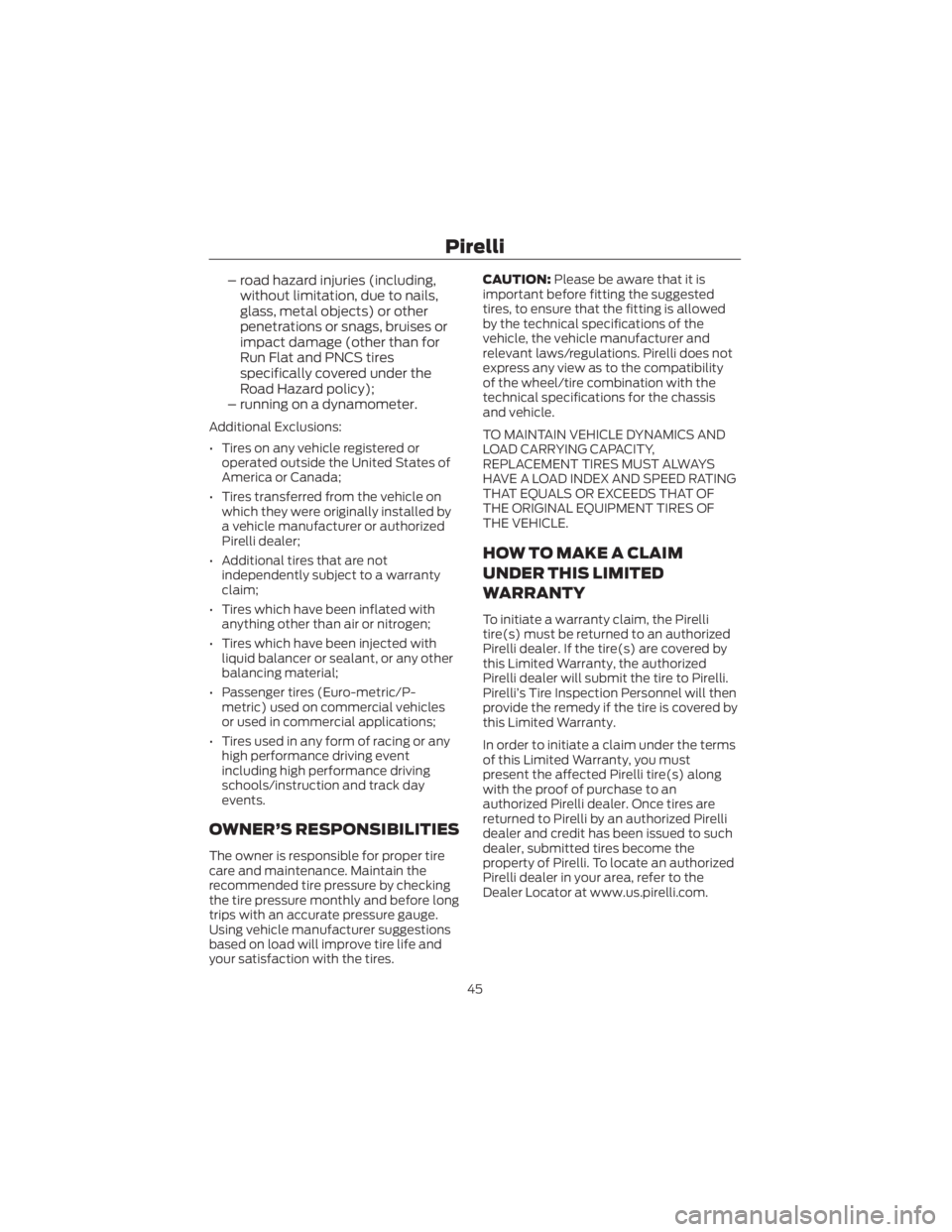
– road hazard injuries (including,without limitation, due to nails,
glass, metal objects) or other
penetrations or snags, bruises or
impact damage (other than for
Run Flat and PNCS tires
specifically covered under the
Road Hazard policy);
– running on a dynamometer.
Additional Exclusions:
• Tires on any vehicle registered or
operated outside the United States of
America or Canada;
• Tires transferred from the vehicle on which they were originally installed by
a vehicle manufacturer or authorized
Pirelli dealer;
• Additional tires that are not independently subject to a warranty
claim;
• Tires which have been inflated with anything other than air or nitrogen;
• Tires which have been injected with liquid balancer or sealant, or any other
balancing material;
• Passenger tires (Euro-metric/P- metric) used on commercial vehicles
or used in commercial applications;
• Tires used in any form of racing or any high performance driving event
including high performance driving
schools/instruction and track day
events.
OWNER’S RESPONSIBILITIES
The owner is responsible for proper tire
care and maintenance. Maintain the
recommended tire pressure by checking
the tire pressure monthly and before long
trips with an accurate pressure gauge.
Using vehicle manufacturer suggestions
based on load will improve tire life and
your satisfaction with the tires. CAUTION:
Please be aware that it is
important before fitting the suggested
tires, to ensure that the fitting is allowed
by the technical specifications of the
vehicle, the vehicle manufacturer and
relevant laws/regulations. Pirelli does not
express any view as to the compatibility
of the wheel/tire combination with the
technical specifications for the chassis
and vehicle.
TO MAINTAIN VEHICLE DYNAMICS AND
LOAD CARRYING CAPACITY,
REPLACEMENT TIRES MUST ALWAYS
HAVE A LOAD INDEX AND SPEED RATING
THAT EQUALS OR EXCEEDS THAT OF
THE ORIGINAL EQUIPMENT TIRES OF
THE VEHICLE.
HOW TO MAKE A CLAIM
UNDER THIS LIMITED
WARRANTY
To initiate a warranty claim, the Pirelli
tire(s) must be returned to an authorized
Pirelli dealer. If the tire(s) are covered by
this Limited Warranty, the authorized
Pirelli dealer will submit the tire to Pirelli.
Pirelli’s Tire Inspection Personnel will then
provide the remedy if the tire is covered by
this Limited Warranty.
In order to initiate a claim under the terms
of this Limited Warranty, you must
present the affected Pirelli tire(s) along
with the proof of purchase to an
authorized Pirelli dealer. Once tires are
returned to Pirelli by an authorized Pirelli
dealer and credit has been issued to such
dealer, submitted tires become the
property of Pirelli. To locate an authorized
Pirelli dealer in your area, refer to the
Dealer Locator at www.us.pirelli.com.
Pirelli
45
Page 50 of 73
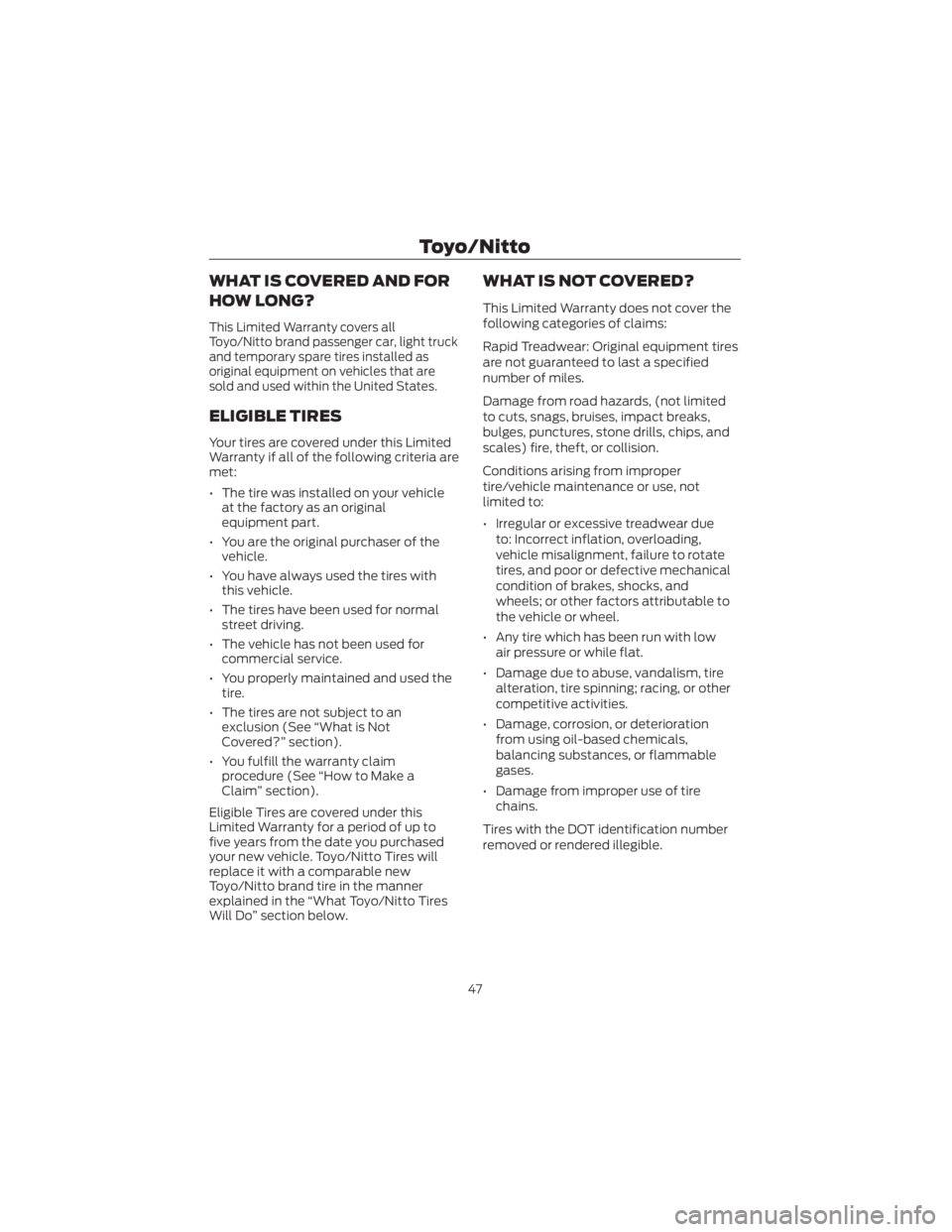
WHAT IS COVERED AND FOR
HOW LONG?
This Limited Warranty covers all
Toyo/Nitto brand passenger car, light truck
and temporary spare tires installed as
original equipment on vehicles that are
sold and used within the United States.
ELIGIBLE TIRES
Your tires are covered under this Limited
Warranty if all of the following criteria are
met:
• The tire was installed on your vehicleat the factory as an original
equipment part.
• You are the original purchaser of the vehicle.
• You have always used the tires with this vehicle.
• The tires have been used for normal street driving.
• The vehicle has not been used for commercial service.
• You properly maintained and used the tire.
• The tires are not subject to an exclusion (See “What is Not
Covered?” section).
• You fulfill the warranty claim procedure (See “How to Make a
Claim” section).
Eligible Tires are covered under this
Limited Warranty for a period of up to
five years from the date you purchased
your new vehicle. Toyo/Nitto Tires will
replace it with a comparable new
Toyo/Nitto brand tire in the manner
explained in the “What Toyo/Nitto Tires
Will Do” section below.
WHAT IS NOT COVERED?
This Limited Warranty does not cover the
following categories of claims:
Rapid Treadwear: Original equipment tires
are not guaranteed to last a specified
number of miles.
Damage from road hazards, (not limited
to cuts, snags, bruises, impact breaks,
bulges, punctures, stone drills, chips, and
scales) fire, theft, or collision.
Conditions arising from improper
tire/vehicle maintenance or use, not
limited to:
• Irregular or excessive treadwear due to: Incorrect inflation, overloading,
vehicle misalignment, failure to rotate
tires, and poor or defective mechanical
condition of brakes, shocks, and
wheels; or other factors attributable to
the vehicle or wheel.
• Any tire which has been run with low air pressure or while flat.
• Damage due to abuse, vandalism, tire alteration, tire spinning; racing, or other
competitive activities.
• Damage, corrosion, or deterioration from using oil-based chemicals,
balancing substances, or flammable
gases.
• Damage from improper use of tire chains.
Tires with the DOT identification number
removed or rendered illegible.
Toyo/Nitto
47
Page 55 of 73
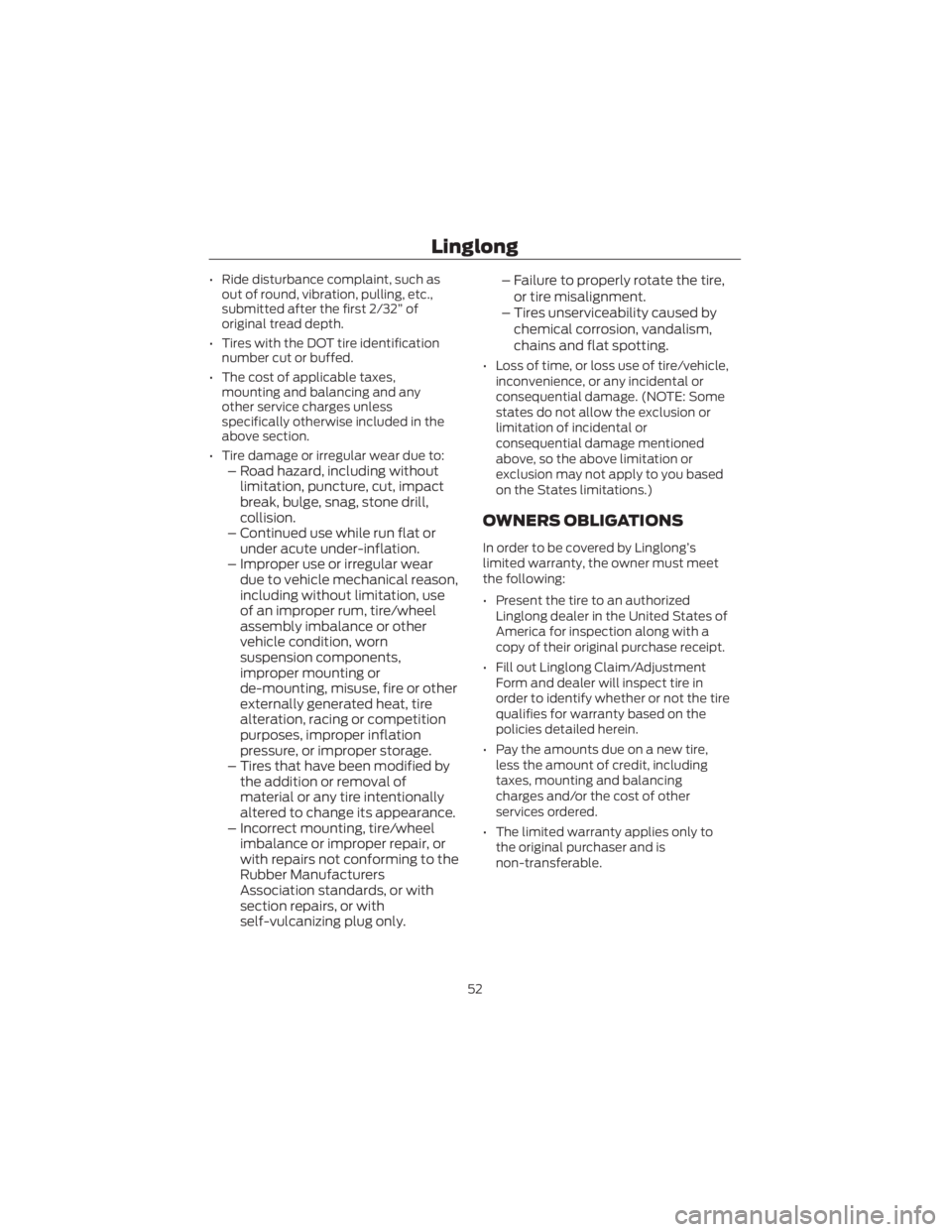
• Ride disturbance complaint, such asout of round, vibration, pulling, etc.,
submitted after the first 2/32” of
original tread depth.
• Tires with the DOT tire identification number cut or buffed.
• The cost of applicable taxes, mounting and balancing and any
other service charges unless
specifically otherwise included in the
above section.
• Tire damage or irregular wear due to:
– Road hazard, including without limitation, puncture, cut, impact
break, bulge, snag, stone drill,
collision.
– Continued use while run flat or under acute under-inflation.
– Improper use or irregular wear due to vehicle mechanical reason,
including without limitation, use
of an improper rum, tire/wheel
assembly imbalance or other
vehicle condition, worn
suspension components,
improper mounting or
de-mounting, misuse, fire or other
externally generated heat, tire
alteration, racing or competition
purposes, improper inflation
pressure, or improper storage.
– Tires that have been modified by the addition or removal of
material or any tire intentionally
altered to change its appearance.
– Incorrect mounting, tire/wheel imbalance or improper repair, or
with repairs not conforming to the
Rubber Manufacturers
Association standards, or with
section repairs, or with
self-vulcanizing plug only. – Failure to properly rotate the tire,
or tire misalignment.
– Tires unserviceability caused by chemical corrosion, vandalism,
chains and flat spotting.
• Loss of time, or loss use of tire/vehicle,
inconvenience, or any incidental or
consequential damage. (NOTE: Some
states do not allow the exclusion or
limitation of incidental or
consequential damage mentioned
above, so the above limitation or
exclusion may not apply to you based
on the States limitations.)
OWNERS OBLIGATIONS
In order to be covered by Linglong’s
limited warranty, the owner must meet
the following:
• Present the tire to an authorizedLinglong dealer in the United States of
America for inspection along with a
copy of their original purchase receipt.
• Fill out Linglong Claim/Adjustment Form and dealer will inspect tire in
order to identify whether or not the tire
qualifies for warranty based on the
policies detailed herein.
• Pay the amounts due on a new tire, less the amount of credit, including
taxes, mounting and balancing
charges and/or the cost of other
services ordered.
• The limited warranty applies only to the original purchaser and is
non-transferable.
Linglong
52
Page 58 of 73
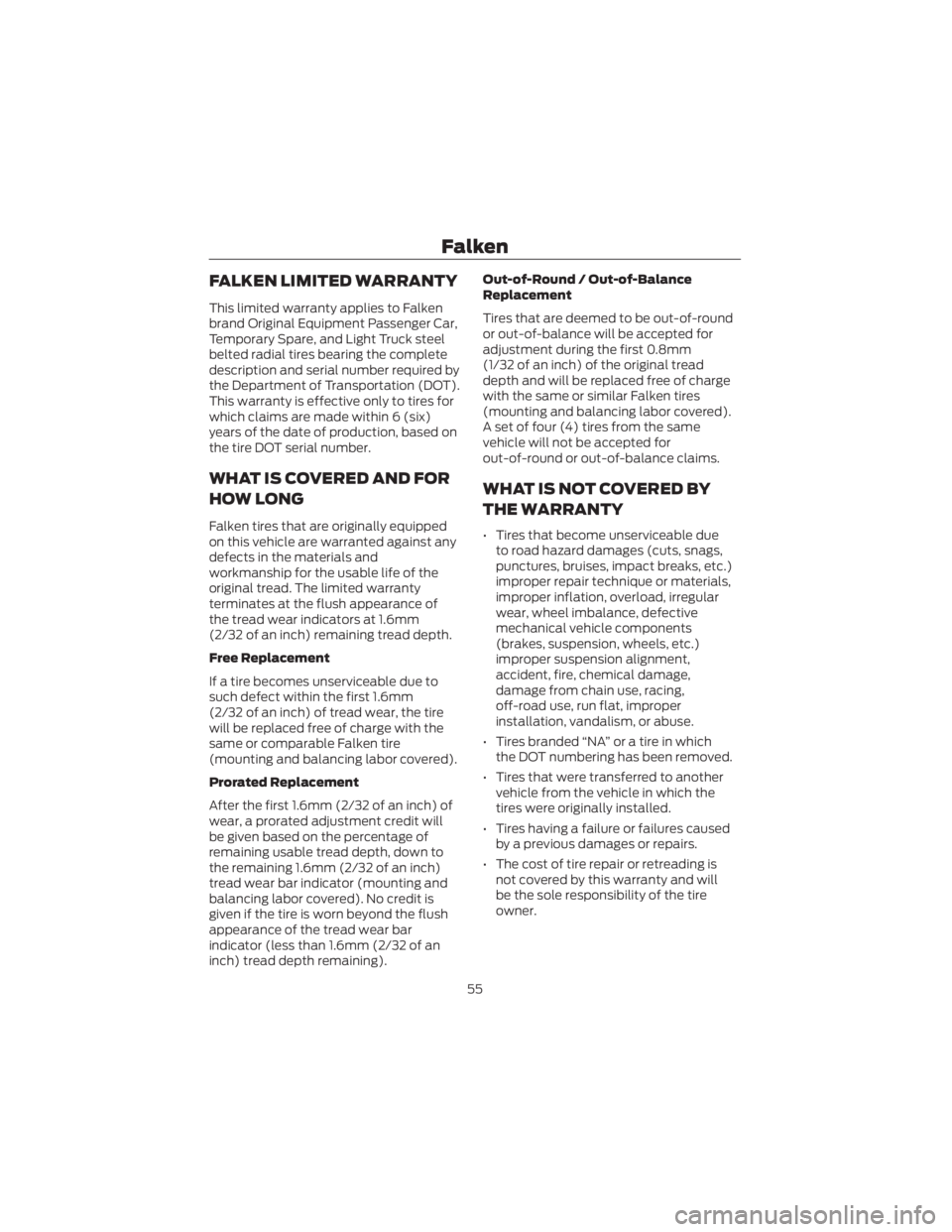
FALKEN LIMITED WARRANTY
This limited warranty applies to Falken
brand Original Equipment Passenger Car,
Temporary Spare, and Light Truck steel
belted radial tires bearing the complete
description and serial number required by
the Department of Transportation (DOT).
This warranty is effective only to tires for
which claims are made within 6 (six)
years of the date of production, based on
the tire DOT serial number.
WHAT IS COVERED AND FOR
HOW LONG
Falken tires that are originally equipped
on this vehicle are warranted against any
defects in the materials and
workmanship for the usable life of the
original tread. The limited warranty
terminates at the flush appearance of
the tread wear indicators at 1.6mm
(2/32 of an inch) remaining tread depth.
Free Replacement
If a tire becomes unserviceable due to
such defect within the first 1.6mm
(2/32 of an inch) of tread wear, the tire
will be replaced free of charge with the
same or comparable Falken tire
(mounting and balancing labor covered).
Prorated Replacement
After the first 1.6mm (2/32 of an inch) of
wear, a prorated adjustment credit will
be given based on the percentage of
remaining usable tread depth, down to
the remaining 1.6mm (2/32 of an inch)
tread wear bar indicator (mounting and
balancing labor covered). No credit is
given if the tire is worn beyond the flush
appearance of the tread wear bar
indicator (less than 1.6mm (2/32 of an
inch) tread depth remaining).Out-of-Round / Out-of-Balance
Replacement
Tires that are deemed to be out-of-round
or out-of-balance will be accepted for
adjustment during the first 0.8mm
(1/32 of an inch) of the original tread
depth and will be replaced free of charge
with the same or similar Falken tires
(mounting and balancing labor covered).
A set of four (4) tires from the same
vehicle will not be accepted for
out-of-round or out-of-balance claims.
WHAT IS NOT COVERED BY
THE WARRANTY
• Tires that become unserviceable due
to road hazard damages (cuts, snags,
punctures, bruises, impact breaks, etc.)
improper repair technique or materials,
improper inflation, overload, irregular
wear, wheel imbalance, defective
mechanical vehicle components
(brakes, suspension, wheels, etc.)
improper suspension alignment,
accident, fire, chemical damage,
damage from chain use, racing,
off-road use, run flat, improper
installation, vandalism, or abuse.
• Tires branded “NA” or a tire in which the DOT numbering has been removed.
• Tires that were transferred to another vehicle from the vehicle in which the
tires were originally installed.
• Tires having a failure or failures caused by a previous damages or repairs.
• The cost of tire repair or retreading is not covered by this warranty and will
be the sole responsibility of the tire
owner.
Falken
55
Page 61 of 73
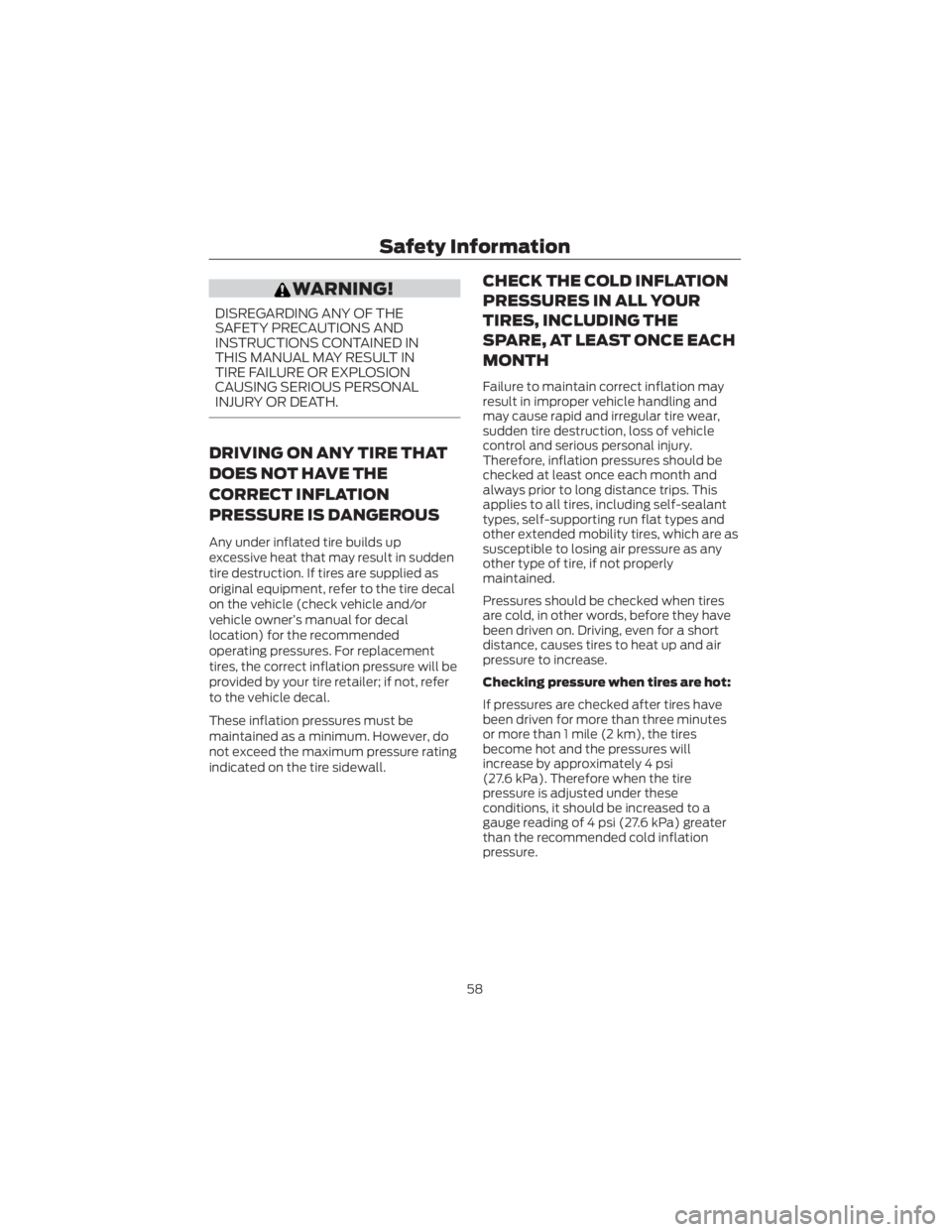
WARNING!
DISREGARDING ANY OF THE
SAFETY PRECAUTIONS AND
INSTRUCTIONS CONTAINED IN
THIS MANUAL MAY RESULT IN
TIRE FAILURE OR EXPLOSION
CAUSING SERIOUS PERSONAL
INJURY OR DEATH.
DRIVING ON ANY TIRE THAT
DOES NOT HAVE THE
CORRECT INFLATION
PRESSURE IS DANGEROUS
Any under inflated tire builds up
excessive heat that may result in sudden
tire destruction. If tires are supplied as
original equipment, refer to the tire decal
on the vehicle (check vehicle and/or
vehicle owner’s manual for decal
location) for the recommended
operating pressures. For replacement
tires, the correct inflation pressure will be
provided by your tire retailer; if not, refer
to the vehicle decal.
These inflation pressures must be
maintained as a minimum. However, do
not exceed the maximum pressure rating
indicated on the tire sidewall.
CHECK THE COLD INFLATION
PRESSURES IN ALL YOUR
TIRES, INCLUDING THE
SPARE, AT LEAST ONCE EACH
MONTH
Failure to maintain correct inflation may
result in improper vehicle handling and
may cause rapid and irregular tire wear,
sudden tire destruction, loss of vehicle
control and serious personal injury.
Therefore, inflation pressures should be
checked at least once each month and
always prior to long distance trips. This
applies to all tires, including self-sealant
types, self-supporting run flat types and
other extended mobility tires, which are as
susceptible to losing air pressure as any
other type of tire, if not properly
maintained.
Pressures should be checked when tires
are cold, in other words, before they have
been driven on. Driving, even for a short
distance, causes tires to heat up and air
pressure to increase.
Checking pressure when tires are hot:
If pressures are checked after tires have
been driven for more than three minutes
or more than 1 mile (2 km), the tires
become hot and the pressures will
increase by approximately 4 psi
(27.6 kPa). Therefore when the tire
pressure is adjusted under these
conditions, it should be increased to a
gauge reading of 4 psi (27.6 kPa) greater
than the recommended cold inflation
pressure.
SafetyInformation
58
Page 62 of 73
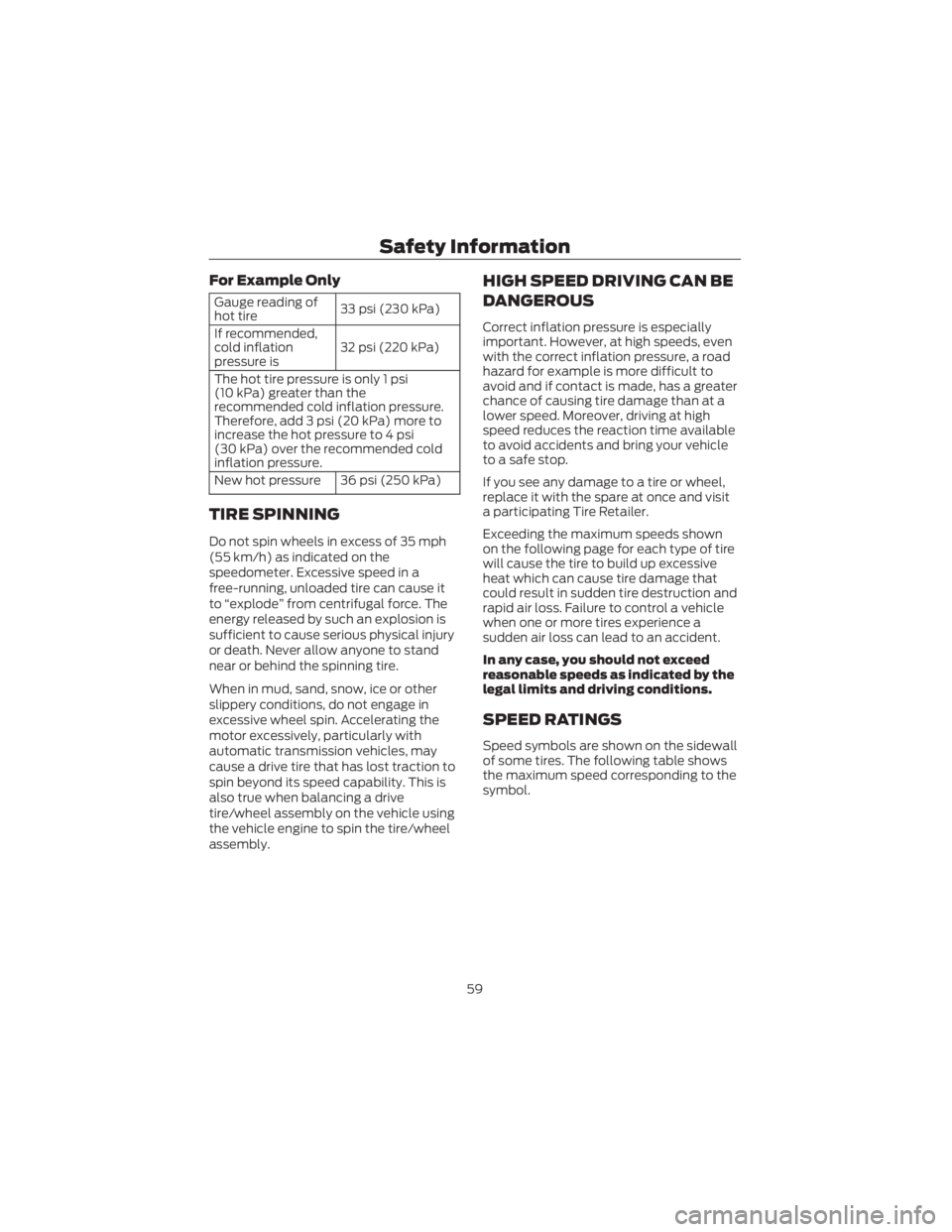
For Example Only
Gauge reading of
hot tire33 psi (230 kPa)
If recommended,
cold inflation
pressure is 32 psi (220 kPa)
The hot tire pressure is only 1 psi
(10 kPa) greater than the
recommended cold inflation pressure.
Therefore, add 3 psi (20 kPa) more to
increase the hot pressure to 4 psi
(30 kPa) over the recommended cold
inflation pressure.
New hot pressure 36 psi (250 kPa)
TIRE SPINNING
Do not spin wheels in excess of 35 mph
(55 km/h) as indicated on the
speedometer. Excessive speed in a
free-running, unloaded tire can cause it
to “explode” from centrifugal force. The
energy released by such an explosion is
sufficient to cause serious physical injury
or death. Never allow anyone to stand
near or behind the spinning tire.
When in mud, sand, snow, ice or other
slippery conditions, do not engage in
excessive wheel spin. Accelerating the
motor excessively, particularly with
automatic transmission vehicles, may
cause a drive tire that has lost traction to
spin beyond its speed capability. This is
also true when balancing a drive
tire/wheel assembly on the vehicle using
the vehicle engine to spin the tire/wheel
assembly.
HIGH SPEED DRIVING CAN BE
DANGEROUS
Correct inflation pressure is especially
important. However, at high speeds, even
with the correct inflation pressure, a road
hazard for example is more difficult to
avoid and if contact is made, has a greater
chance of causing tire damage than at a
lower speed. Moreover, driving at high
speed reduces the reaction time available
to avoid accidents and bring your vehicle
to a safe stop.
If you see any damage to a tire or wheel,
replace it with the spare at once and visit
a participating Tire Retailer.
Exceeding the maximum speeds shown
on the following page for each type of tire
will cause the tire to build up excessive
heat which can cause tire damage that
could result in sudden tire destruction and
rapid air loss. Failure to control a vehicle
when one or more tires experience a
sudden air loss can lead to an accident.
In any case, you should not exceed
reasonable speeds as indicated by the
legal limits and driving conditions.
SPEED RATINGS
Speed symbols are shown on the sidewall
of some tires. The following table shows
the maximum speed corresponding to the
symbol.
Safety Information
59
Page 65 of 73
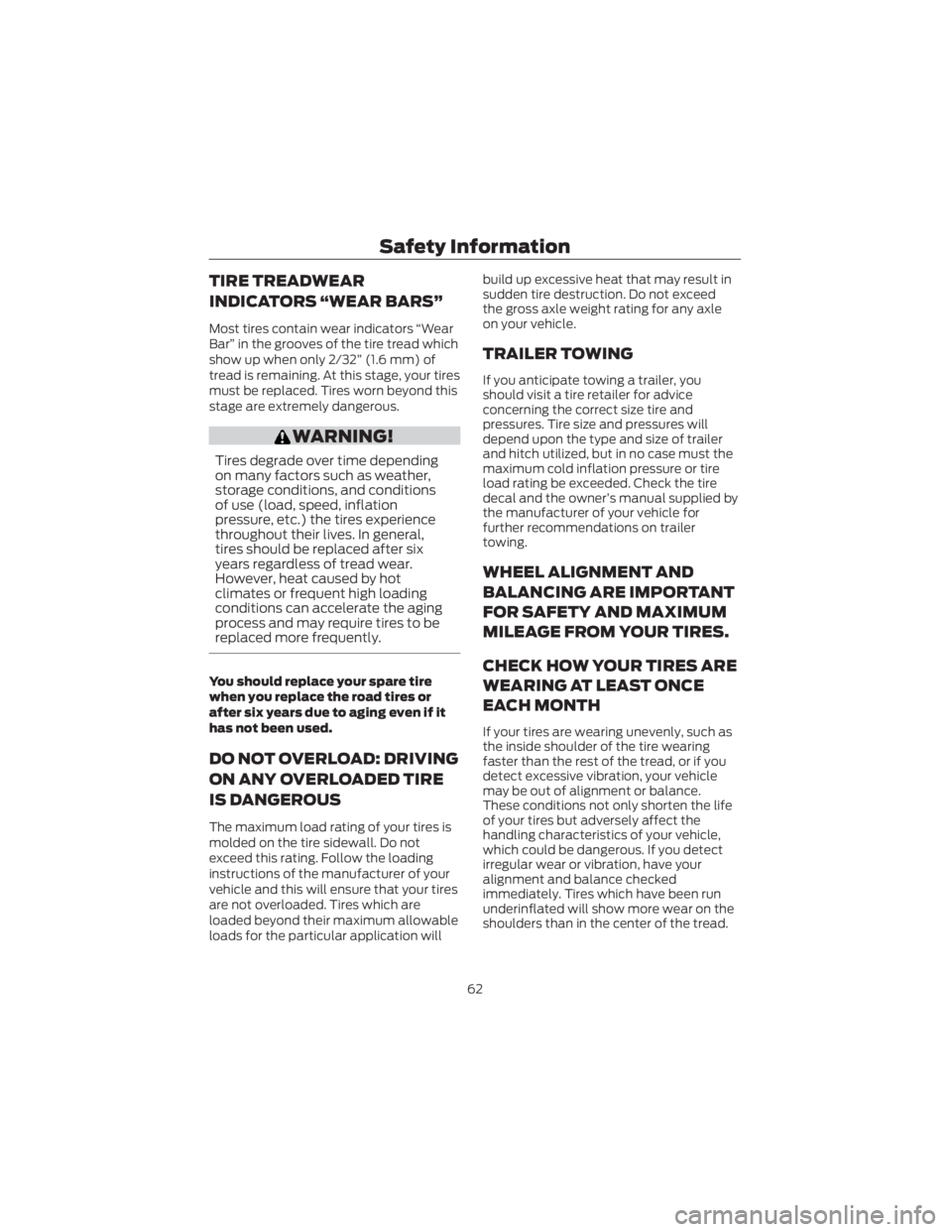
TIRE TREADWEAR
INDICATORS “WEAR BARS”
Most tires contain wear indicators “Wear
Bar” in the grooves of the tire tread which
show up when only 2/32” (1.6 mm) of
tread is remaining. At this stage, your tires
must be replaced. Tires worn beyond this
stage are extremely dangerous.
WARNING!
Tires degrade over time depending
on many factors such as weather,
storage conditions, and conditions
of use (load, speed, inflation
pressure, etc.) the tires experience
throughout their lives. In general,
tires should be replaced after six
years regardless of tread wear.
However, heat caused by hot
climates or frequent high loading
conditions can accelerate the aging
process and may require tires to be
replaced more frequently.
You should replace your spare tire
when you replace the road tires or
after six years due to aging even if it
has not been used.
DO NOT OVERLOAD: DRIVING
ON ANY OVERLOADED TIRE
IS DANGEROUS
The maximum load rating of your tires is
molded on the tire sidewall. Do not
exceed this rating. Follow the loading
instructions of the manufacturer of your
vehicle and this will ensure that your tires
are not overloaded. Tires which are
loaded beyond their maximum allowable
loads for the particular application willbuild up excessive heat that may result in
sudden tire destruction. Do not exceed
the gross axle weight rating for any axle
on your vehicle.
TRAILER TOWING
If you anticipate towing a trailer, you
should visit a tire retailer for advice
concerning the correct size tire and
pressures. Tire size and pressures will
depend upon the type and size of trailer
and hitch utilized, but in no case must the
maximum cold inflation pressure or tire
load rating be exceeded. Check the tire
decal and the owner’s manual supplied by
the manufacturer of your vehicle for
further recommendations on trailer
towing.
WHEEL ALIGNMENT AND
BALANCING ARE IMPORTANT
FOR SAFETY AND MAXIMUM
MILEAGE FROM YOUR TIRES.
CHECK HOW YOUR TIRES ARE
WEARING AT LEAST ONCE
EACH MONTH
If your tires are wearing unevenly, such as
the inside shoulder of the tire wearing
faster than the rest of the tread, or if you
detect excessive vibration, your vehicle
may be out of alignment or balance.
These conditions not only shorten the life
of your tires but adversely affect the
handling characteristics of your vehicle,
which could be dangerous. If you detect
irregular wear or vibration, have your
alignment and balance checked
immediately. Tires which have been run
underinflated will show more wear on the
shoulders than in the center of the tread.
Safety
Information
62
Page 67 of 73
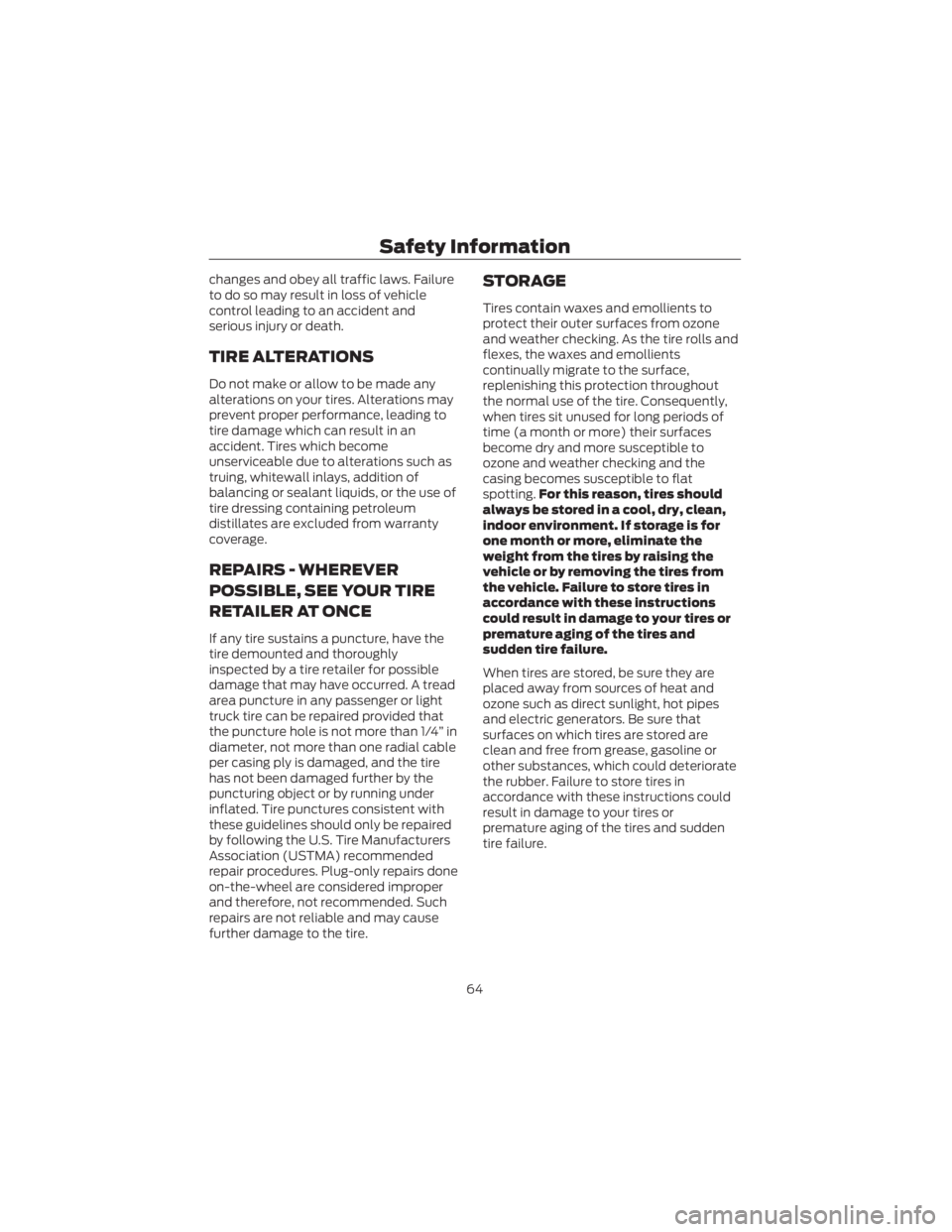
changes and obey all traffic laws. Failure
to do so may result in loss of vehicle
control leading to an accident and
serious injury or death.
TIRE ALTERATIONS
Do not make or allow to be made any
alterations on your tires. Alterations may
prevent proper performance, leading to
tire damage which can result in an
accident. Tires which become
unserviceable due to alterations such as
truing, whitewall inlays, addition of
balancing or sealant liquids, or the use of
tire dressing containing petroleum
distillates are excluded from warranty
coverage.
REPAIRS - WHEREVER
POSSIBLE, SEE YOUR TIRE
RETAILER AT ONCE
If any tire sustains a puncture, have the
tire demounted and thoroughly
inspected by a tire retailer for possible
damage that may have occurred. A tread
area puncture in any passenger or light
truck tire can be repaired provided that
the puncture hole is not more than 1/4” in
diameter, not more than one radial cable
per casing ply is damaged, and the tire
has not been damaged further by the
puncturing object or by running under
inflated. Tire punctures consistent with
these guidelines should only be repaired
by following the U.S. Tire Manufacturers
Association (USTMA) recommended
repair procedures. Plug-only repairs done
on-the-wheel are considered improper
and therefore, not recommended. Such
repairs are not reliable and may cause
further damage to the tire.
STORAGE
Tires contain waxes and emollients to
protect their outer surfaces from ozone
and weather checking. As the tire rolls and
flexes, the waxes and emollients
continually migrate to the surface,
replenishing this protection throughout
the normal use of the tire. Consequently,
when tires sit unused for long periods of
time (a month or more) their surfaces
become dry and more susceptible to
ozone and weather checking and the
casing becomes susceptible to flat
spotting.For this reason, tires should
always be stored in a cool, dry, clean,
indoor environment. If storage is for
one month or more, eliminate the
weight from the tires by raising the
vehicle or by removing the tires from
the vehicle. Failure to store tires in
accordance with these instructions
could result in damage to your tires or
premature aging of the tires and
sudden tire failure.
When tires are stored, be sure they are
placed away from sources of heat and
ozone such as direct sunlight, hot pipes
and electric generators. Be sure that
surfaces on which tires are stored are
clean and free from grease, gasoline or
other substances, which could deteriorate
the rubber. Failure to store tires in
accordance with these instructions could
result in damage to your tires or
premature aging of the tires and sudden
tire failure.
Safety Information
64
Page 71 of 73
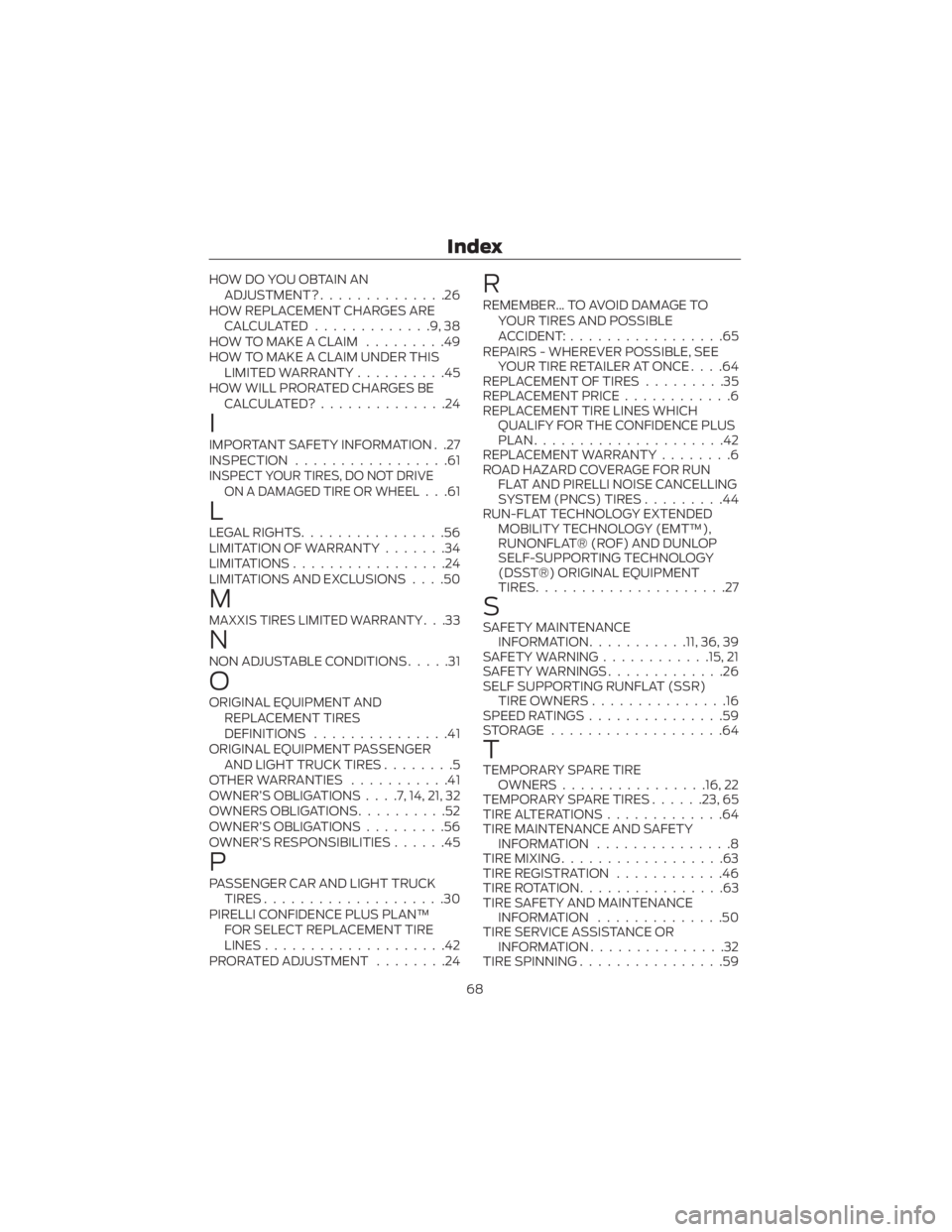
HOW DO YOU OBTAIN ANADJUSTMENT? ..............26
HOW REPLACEMENT CHARGES ARE CALCULATED .............9,38
HOW TO MAKE A CLAIM .........49
HOW TO MAKE A CLAIM UNDER THIS LIMITED WARRANTY ..........45
HOW WILL PRORATED CHARGES BE CALCULATED?..............24
I
IMPORTANT SAFETY INFORMATION . .27
INSPECTION .................61
INSPECT YOUR TIRES, DO NOT DRIVE
ON A DAMAGED TIRE OR WHEEL...61
L
LEGAL RIGHTS ................56
LIMITATION OF WARRANTY .......34
LIMITATIONS .................24
LIMITATIONS AND EXCLUSIONS ....50
M
MAXXIS TIRES LIMITED WARRANTY. . .33
N
NON ADJUSTABLE CONDITIONS.....31
O
ORIGINAL EQUIPMENT AND
REPLACEMENT TIRES
DEFINITIONS ...............41
ORIGINAL EQUIPMENT PASSENGER AND LIGHT TRUCK TIRES ........5
OTHER WARRANTIES ...........41
OWNER’S OBLIGATIONS . . . .7, 14, 21, 32
OWNERS OBLIGATIONS ..........52
OWNER’S OBLIGATIONS .........56
OWNER’S RESPONSIBILITIES ......45
P
PASSENGER CAR AND LIGHT TRUCK
TIRES ....................30
PIRELLI CONFIDENCE PLUS PLAN™ FOR SELECT REPLACEMENT TIRE
LINES ....................42
PRORATED ADJUSTMENT ........24
R
REMEMBER... TO AVOID DAMAGE TO
YOUR TIRES AND POSSIBLE
ACCIDENT: .................65
REPAIRS - WHEREVER POSSIBLE, SEE YOUR TIRE RETAILER AT ONCE ....64
REPLACEMENT OF TIRES .........35
REPLACEMENT PRICE ............6
REPLACEMENT TIRE LINES WHICH QUALIFY FOR THE CONFIDENCE PLUS
PLAN .....................42
REPLACEMENT WARRANTY ........6
ROAD HAZARD COVERAGE FOR RUN FLAT AND PIRELLI NOISE CANCELLING
SYSTEM (PNCS) TIRES .........44
RUN-FLAT TECHNOLOGY EXTENDED MOBILITY TECHNOLOGY (EMT™),
RUNONFLAT® (ROF) AND DUNLOP
SELF-SUPPORTING TECHNOLOGY
(DSST®) ORIGINAL EQUIPMENT
TIRES .....................27
S
SAFETY MAINTENANCE
INFORMATION ...........11, 36, 39
SAFETY WARNING ............15, 21
SAFETY WARNINGS .............26
SELF SUPPORTING RUNFLAT (SSR) TIRE OWNERS ...............16
SPEED RATINGS ...............59
STORAGE ...................64
T
TEMPORARY SPARE TIRE OWNERS ................16, 22
TEMPORARY SPARE TIRES ......23, 65
TIRE ALTERATIONS .............64
TIRE MAINTENANCE AND SAFETY INFORMATION ...............8
TIRE MIXING ..................63
TIRE REGISTRATION ............46
TIRE ROTATION ................63
TIRE SAFETY AND MAINTENANCE INFORMATION ..............50
TIRE SERVICE ASSISTANCE OR INFORMATION ...............32
TIRE SPINNING ................59
Index
68